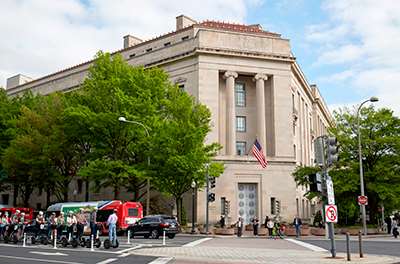
While Americans are frequently confronted with stories centered on guns being used to take lives, few are aware that many more humans are likely saved by firearms every year. A key reason for this lack of understanding is unreliable federal crime data—data that has too often been skewed by anti-gun politics.
As currently defined by the FBI, active-shooter incidents involve individuals who kill or attempt to kill people in a populated, public place, even if only one shot is fired or the intended target is not struck. Shootings that are related to other criminal activities, such as robberies or drug-turf wars, are not included in the FBI’s “Active Shooter Incident” reports.
But, according to economist John Lott, there was an abundance of cases missing or misidentified by the FBI, and while the FBI acknowledged errors, the Bureau failed to update the reports for accuracy purposes. Lott is the president and founder of the Crime Prevention Research Center (CPRC), and also worked in the U.S. Department of Justice (DOJ) up until January 2021 as senior advisor for research and statistics evalutating the FBI’s reports.
“The FBI continues to report that armed citizens stopped only 14 of the 302 active shooter incidents that it identified for the period 2014-2022. The correct rate is almost eight times higher. And if we limit the discussion to places where permit holders were allowed to carry, the rate is eleven times higher,” wrote Lott. He further noted, “[O]ut of 440 active shooter incidents from 2014 to 2022, an armed citizen stopped 157. We also found that the FBI had misidentified five cases, usually because the person who stopped the attack was incorrectly identified as a security guard.”
He also emphasized that while the FBI claims that just 4.6% of active murderers were halted by law-abiding citizens carrying guns, his research found that the figure was at least 35.7%. A false statistic—like this 4.6%—misleads people and can prevent good policies from being passed.
Indeed, without reliable crime data, it is impossible to have a fair “gun-control” debate, and yet the FBI continues to depend upon minimal data sets to reach conclusions meant to encapsulate the entire country.
For example, the FBI estimates national crime trends by collecting crime reports from thousands of law-enforcement agencies nationwide for its annual Uniform Crime Reporting (UCR) Program; however, in 2021, the Bureau made momentous changes to how local, county, state, tribal and federal agencies submit their information. The FBI said that agencies and police departments could only submit data via their NIBRS platform, which brought about yet another significant administrative hurdle.
The outcome? Of the 18,000 agencies nationwide, only half filed a year’s worth of data, and only 63% put forth partial information. This made already dubious data even more deceptive and spotty; in fact, the country’s biggest cities, New York and Los Angeles, failed to report statistics to the FBI at all. Subsequently, the FBI often draws its conclusions using a small percentage of jurisdictions—or none—in a state to conjure up a national estimate. The lack of crime data from big cities can also lead to the perception that those cities (or the states they are in) are safer than they are.
Despite this knowledge, the FBI still tries to convince the public that the UCR Program “generates reliable statistics for use in law enforcement.”
“It also provides information for students of criminal justice, researchers, the media and the public. The program has been providing crime statistics since 1930,” the FBI says on its website. “The UCR Program includes data from more than 18,000 city, university and college, county, state, tribal and federal law enforcement agencies. Agencies participate voluntarily and submit their crime data either through a state UCR program or directly to the FBI’s UCR Program.”
What the FBI additionally fails to acknowledge is how data and subsequent reports are generated, which always leaves it open to inconsistencies, errors and manipulations. At every stage of the data-collection process, bias and distortion can infect a narrative. Different officers can interpret the same alleged criminal event in varying ways. Downgrading or upgrading a charge may be incentivized or pressured for political reasons. Even minor reporting disparities can significantly affect the final outcome—impacting the public’s right to definitive and transparent information concerning their safety.
And, as it pertains to lawful firearms use, national data is far from a dependable source. For one, the FBI does not distinguish between law-abiding citizens preventing attacks where guns are prohibited and where they are legally permitted. As Lott said, “You can’t expect law-abiding citizens to stop attacks where it is illegal to carry guns.”
“In places where law-abiding citizens are allowed to carry firearms, the percentage of active shootings that were stopped is 51%,” said Lott. “For 2022, that figure is a remarkable 63.5%.”

Furthermore, the FBI draws determinations regarding the prevention of attacks. These are not even based on the limited information police departments can provide but are often based on hard-to-find news stories concerning such incidents. Some of this data is compiled by academics—paid for with your tax dollars—at the Advanced Law Enforcement Rapid Response Training Center at Texas State University. Those researchers, too, are subject to prejudice and subjective interpretation. In Lott’s experience in pointing out errors to those tasked with compiling the reports, only one researcher responded to his query about why a particular case of a shooting being stopped by a lawful person with a firearm had failed to make the FBI’s final report.
“He argued that one case involving a shooting at a dentist’s office was excluded because it involved a domestic dispute and another at a strip club because it was a ‘retaliation murder,’” said Lott. “We list 14 examples where the FBI list includes shootings resulting from domestic disputes and three others where a shooting started after someone was denied entry to a lounge or bar. So why the double standard? Domestic disputes and ‘retaliation murders’ are only included when they don’t involve permit holders stopping the attacks.”
Experts like Lott deduce that the FBI data on active murderers is bereft of so many defensive gun uses that one can’t help but view this as calculated.
“Errors can happen, but the failure to fix past reports shows a troubling disregard for the truth,” said Lott. “The reality is that armed, law-abiding citizens are unsung guardian angels.”
Nevertheless, the FBI wouldn’t be the first government entity contaminated by the fervent gun-control agenda of the Biden administration.
Last year, the Centers for Disease Control and Prevention (CDC)—the supposedly non-partisan national public health agency of the United States—quietly deleted some data on defensive gun uses from its website. Previously, anyone could turn to the CDC online and see for themselves that guns utilized in defense of oneself or others far surpassed the number of violent gun crimes, with the agency citing a 2013 National Academies of Sciences report conveying that the yearly number of people using guns to stop crime ranged from about 64,000 to 3 million. A figure of 2.5 million was listed on the CDC website.
With such skewed statistics, this isn’t a fair debate; it is a political attack to take away our freedom.
The CDC went on to state that “some studies on the association between self-defensive gun use and injury or loss to the victim have found less loss and injury when a firearm is used,” indicating that firearms are far more likely to save lives than take them.
So why the deletion? The CDC cowed to the lobbying and political pressure of gun-control activists, who were aghast that such figures were used in gun-control discussions. Ultimately, these facts went against the grain of their boisterous fake narrative. According to some independent investigations into the matter, the CDC “initially resisted the removal of the study. But after a meeting in September of 2021, decided to go forward with the requests.”
It seems that the FBI has also gone down a similar partisan path.
“The Bureau’s senior leadership has clearly shown in recent years that they are subject to political interference and influence,” said Del Wilber, a former U.S. federal agent and Second Amendment proponent. “Lower-level Bureau employees tasked with compiling statistical data are certainly influenced by their superiors.”
The Bureau did not respond to a request for comments concerning the accuracy of its reports.
Meanwhile, the national press relies heavily on the untrustworthy government data when reporting on the Second Amendment and gun-control matters. Indeed, many in the mainstream media use this data to attack this civil right.
But still, what FBI reports do show—although they don’t explicitly say so—is that mass shootings almost always occur in “gun-free zones.” One only needs to glance at the FBI’s 2022 Active Shooter Locations with Five Highest Casualty Counts—Club Q in Colorado Springs, Colo.; Robb Elementary School in Uvalde, Texas; 36th Street Station in Brooklyn, N.Y.; Tops Friendly Markets in Buffalo, N.Y. and Central Avenue in Highland Park, Ill.—to determine these areas did not permit law-abiding citizens to carry. Findings from the CPRC further illuminate that 97.8% of mass shootings from 1950 to May 2018 occurred in such firearm-prohibited areas.
Yet, at least on national news platforms, you would be hard-pressed to find out about the deluge of occurrences each year in which legal armed citizens save lives and don’t accidentally hurt innocent bystanders.
“We rarely hear about guns being used to prevent crimes for one simple reason. It goes contrary to the false narrative that the leftist news media and politicians want to paint,” said Wilber. “There are countless incidents across the country every year where a responsible gun owner has used a gun to prevent or limit an attack or to detain a criminal for the police. These instances will never receive the media attention they merit.”
Emily Miller, a longtime journalist focused on firearms issues, concurred. “There has been an extreme rise in the mainstream media covering gun issues. But it is just astounding how often mainstream media will make mistakes, and it’s about guns and their uses because they don’t learn the basics,” she said. “And sadly, the media’s focus is always on ratings and clicks. Someone shooting children in school will get a lot more attention than someone who saved lives.”
While crime remains at the fore-front of political news cycles, the defensive use of guns is drastically underreported. Sometimes the bending of the story starts with law enforcement itself; for example, in June, a “good guy with a gun” (an employee of a condo) disarmed an active murderer in Las Vegas, as shown by building video footage, thus saving an unknown number of lives. The aggressor was the only person wounded by gunfire, but the heroic role of the armed civilian’s intervention was mysteriously ignored by much of the media.
“Normally, this type of defensive gun use would garner significant media attention and make national headlines. Entire news cycles were dedicated to covering gun owners who stopped mass shootings at an Indiana shopping mall and a Texas church,” said an article by The Heritage Foundation. “Yet, despite undeniable evidence that an armed civilian successfully ended a serious incident in which a gunman was bent on violence, the mantra of the Las Vegas Metropolitan Police Department so far has been: ‘Nothing to see here, folks. Just move along.’ Meanwhile, the mainstream media, including local news outlets, compliantly stopped asking questions.”
With such skewed statistics and stories, this isn’t a fair debate; it is a political attack to take away our freedom. If we don’t stand up for accuracy and point out the problems with these government statistics, our rights will inevitably diminish under the canopy of a political agenda.
“The manipulation of statistics to create a narrative ultimately scares people. Whether the goal is for ratings or more gun control, it pushes people, especially women and mothers, to fear guns,” said Miller. “And that just isn’t right.”


































